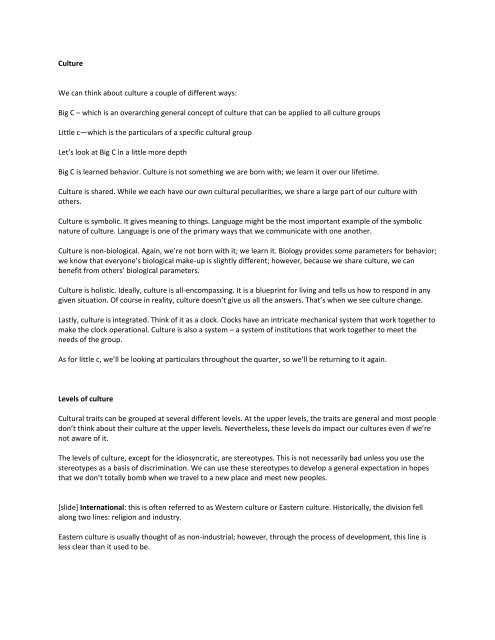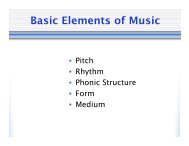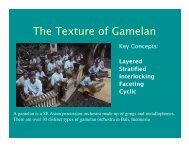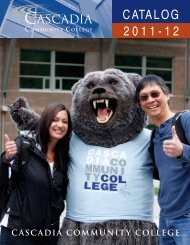Culture We can think about culture a couple of different ways: Big C ...
Culture We can think about culture a couple of different ways: Big C ...
Culture We can think about culture a couple of different ways: Big C ...
You also want an ePaper? Increase the reach of your titles
YUMPU automatically turns print PDFs into web optimized ePapers that Google loves.
<strong>Culture</strong><br />
<strong>We</strong> <strong>can</strong> <strong>think</strong> <strong>about</strong> <strong>culture</strong> a <strong>couple</strong> <strong>of</strong> <strong>different</strong> <strong>ways</strong>:<br />
<strong>Big</strong> C – which is an overarching general concept <strong>of</strong> <strong>culture</strong> that <strong>can</strong> be applied to all <strong>culture</strong> groups<br />
Little c—which is the particulars <strong>of</strong> a specific cultural group<br />
Let’s look at <strong>Big</strong> C in a little more depth<br />
<strong>Big</strong> C is learned behavior. <strong>Culture</strong> is not something we are born with; we learn it over our lifetime.<br />
<strong>Culture</strong> is shared. While we each have our own cultural peculiarities, we share a large part <strong>of</strong> our <strong>culture</strong> with<br />
others.<br />
<strong>Culture</strong> is symbolic. It gives meaning to things. Language might be the most important example <strong>of</strong> the symbolic<br />
nature <strong>of</strong> <strong>culture</strong>. Language is one <strong>of</strong> the primary <strong>ways</strong> that we communicate with one another.<br />
<strong>Culture</strong> is non-biological. Again, we’re not born with it; we learn it. Biology provides some parameters for behavior;<br />
we know that everyone’s biological make-up is slightly <strong>different</strong>; however, because we share <strong>culture</strong>, we <strong>can</strong><br />
benefit from others’ biological parameters.<br />
<strong>Culture</strong> is holistic. Ideally, <strong>culture</strong> is all-encompassing. It is a blueprint for living and tells us how to respond in any<br />
given situation. Of course in reality, <strong>culture</strong> doesn’t give us all the answers. That’s when we see <strong>culture</strong> change.<br />
Lastly, <strong>culture</strong> is integrated. Think <strong>of</strong> it as a clock. Clocks have an intricate mechanical system that work together to<br />
make the clock operational. <strong>Culture</strong> is also a system – a system <strong>of</strong> institutions that work together to meet the<br />
needs <strong>of</strong> the group.<br />
As for little c, we’ll be looking at particulars throughout the quarter, so we’ll be returning to it again.<br />
Levels <strong>of</strong> <strong>culture</strong><br />
Cultural traits <strong>can</strong> be grouped at several <strong>different</strong> levels. At the upper levels, the traits are general and most people<br />
don’t <strong>think</strong> <strong>about</strong> their <strong>culture</strong> at the upper levels. Nevertheless, these levels do impact our <strong>culture</strong>s even if we’re<br />
not aware <strong>of</strong> it.<br />
The levels <strong>of</strong> <strong>culture</strong>, except for the idiosyncratic, are stereotypes. This is not necessarily bad unless you use the<br />
stereotypes as a basis <strong>of</strong> discrimination. <strong>We</strong> <strong>can</strong> use these stereotypes to develop a general expectation in hopes<br />
that we don’t totally bomb when we travel to a new place and meet new peoples.<br />
[slide] International: this is <strong>of</strong>ten referred to as <strong>We</strong>stern <strong>culture</strong> or Eastern <strong>culture</strong>. Historically, the division fell<br />
along two lines: religion and industry.<br />
Eastern <strong>culture</strong> is usually thought <strong>of</strong> as non-industrial; however, through the process <strong>of</strong> development, this line is<br />
less clear than it used to be.
Eastern <strong>culture</strong> also refers to a <strong>different</strong> way <strong>of</strong> <strong>think</strong>ing which is best exemplified in the East’s religions such as<br />
Islam, Buddhism, Hinduism, Confucianism, etc. Interdependence <strong>of</strong> people is a defining characteristic <strong>of</strong> “eastern”<br />
philosophy. Duty to family over self is stressed.<br />
The other thing that encapsulates eastern <strong>culture</strong> is their approach to healing—in the east, it is generally believed<br />
to be ancient, naturalistic traditions…<strong>think</strong> acupuncture and herbal remedies.<br />
<strong>We</strong>stern <strong>culture</strong> is industrial; capitalism rules and behavior geared for independent success is stressed.<br />
<strong>We</strong>stern <strong>culture</strong>s are primarily Christian.<br />
Obviously none <strong>of</strong> these broad geographic areas are all one thing or the other, but <strong>think</strong> in terms <strong>of</strong> dominance.<br />
Eastern <strong>culture</strong>s do encourage people to develop their skills; it’s just that it is not for themselves, but for their<br />
group (which <strong>can</strong> be family, village, or some other entity). In western <strong>culture</strong>s, duty to family is not absent; it’s just<br />
not stressed as strongly.<br />
In regards to health, highly educated doctors and scientifically developed medicines are predominant.<br />
Again, keep in mind that the East vs. <strong>We</strong>st mentality or approach is rapidly breaking down through the process <strong>of</strong><br />
globalization.<br />
[slide] National: Just as the word implies, we’re talking <strong>about</strong> a country’s <strong>culture</strong>. For instance, if someone talks<br />
<strong>about</strong> the Irish, certain mental pictures come to mind.<br />
Within the national <strong>culture</strong>, there are sub-<strong>culture</strong>s. Sub<strong>culture</strong>s exist within the framework <strong>of</strong> the national <strong>culture</strong>,<br />
which in and <strong>of</strong> itself is a sub<strong>culture</strong> <strong>of</strong> international <strong>culture</strong>. Sub<strong>culture</strong>s incorporate values and norms from the<br />
national <strong>culture</strong>, but perhaps not all <strong>of</strong> the values and norms.<br />
[slide] First let’s look at regional <strong>culture</strong>. If I was to talk <strong>about</strong> the United States in terms <strong>of</strong> the South, the Midwest,<br />
or the Southwest, we start to make some assumptions <strong>about</strong> the <strong>culture</strong> <strong>of</strong> individuals from those geographic<br />
regions.<br />
[slide] Same thing with state-level <strong>culture</strong>. I’m originally from Ohio, so I’m going to use Ohio and Kentucky as<br />
examples. Many Ohioans view Kentucky as backward, with people living in remote hollows, little access to<br />
education, and steeped in the <strong>culture</strong> <strong>of</strong> the Civil War-era south. Mint juleps and the Kentucky Derby are<br />
inseparable from Kentucky’s <strong>culture</strong>. When people find out I am from Ohio, I <strong>of</strong>ten hear comments like, “That’s too<br />
bad,” or “Oh, Ohio,” and even “Is the election fraud really that bad there” <strong>We</strong> all have ideas <strong>about</strong> what each<br />
state is like.<br />
[slide] The next sub<strong>culture</strong> I want to talk <strong>about</strong> is the local <strong>culture</strong>. This could be along the lines <strong>of</strong> urban vs,<br />
suburban vs. rural. It could be something like Seattle vs. Tacoma. It could be a neighborhood. There are a lot <strong>of</strong><br />
<strong>ways</strong> to view the local. When I told friends I was moving to Seattle, most said, “You’d better be willing to drink a lot<br />
<strong>of</strong> c<strong>of</strong>fee.” That is an example <strong>of</strong> a local trait. A local trait might also be something along the lines <strong>of</strong> Emo, Grunge,<br />
or even occupations.<br />
[slide] There are also counter-<strong>culture</strong>s. Counter-<strong>culture</strong>s go against something in the mainstream or dominant<br />
<strong>culture</strong>. The classic example <strong>of</strong> a counter-<strong>culture</strong> is the hippie/protest movement during the 1960s in the United<br />
States. A more recent example is the anti-globalization movement.<br />
[slide] The final level <strong>of</strong> <strong>culture</strong> I want to discuss is the idiosyncratic <strong>culture</strong>. This refers to our personal <strong>culture</strong>. <strong>We</strong><br />
are influenced by and choose norms from all <strong>of</strong> the previous levels <strong>of</strong> <strong>culture</strong> to create our personal <strong>culture</strong>s. Our<br />
family and friends are <strong>of</strong>ten most influential but as we mature and move away from home, our personal <strong>culture</strong><br />
may begin to look nothing like the <strong>culture</strong> we grew up in.
For your <strong>culture</strong> map assignment, you’ll need to incorporate elements from each level <strong>of</strong> <strong>culture</strong> in to your graphic<br />
representation <strong>of</strong> your idiosyncratic <strong>culture</strong>.<br />
[slide] Moving on. <strong>Culture</strong> is both overt and covert. What we mean by this is that there are elements <strong>of</strong> <strong>culture</strong><br />
that we are specifically taught…how to eat with utensils or how to ride a bicycle. But there are also elements that<br />
we are not taught…a good example <strong>of</strong> this is proxemics *spell for students+. Proxemics refers to our personal<br />
bubble---how much space we need around our physical person. In the United States, we have a large personal<br />
bubble. <strong>We</strong> don’t like people to get near to us unless invited. Standing smushed up against someone else on the<br />
bus is considered bad manners in the US. <strong>We</strong> aren’t specifically taught this; we pick it up through observation.<br />
<strong>We</strong> <strong>think</strong> <strong>about</strong> our <strong>culture</strong>, particularly our national <strong>culture</strong>, in its ideal form. For instance, when asked to describe<br />
the values <strong>of</strong> US <strong>culture</strong>, people <strong>of</strong>ten mention equality, democracy, and freedom. The reality <strong>of</strong> US <strong>culture</strong> is that<br />
there is not complete equality <strong>of</strong> citizens and some believe the US only promotes democracy unequally across the<br />
globe.<br />
All <strong>of</strong> these things contribute to our world view. World view is a way <strong>of</strong> understanding how the world works and<br />
what our place is in it. Everyone has a world view that impacts their perceptions and interpretations <strong>of</strong> events<br />
occurring in their lives. Some people <strong>think</strong> everyone else interprets or sees things the same way they do. This is<br />
referred to as naïve realism. I <strong>think</strong> we all start out that way, but through education, our naïve realism goes away<br />
as we learn <strong>about</strong> other people’s perspectives…in effect, our <strong>culture</strong> is changing.<br />
[slide] <strong>Culture</strong>s change in a number <strong>of</strong> <strong>ways</strong>. The only way new cultural traits emerge is through the process <strong>of</strong><br />
discovery and invention. Someone perceives a need and invents something to meet that need. Seems a simple<br />
enough concept; however, it <strong>of</strong>ten takes a long time for a new invention to be totally integrated into a <strong>culture</strong>.<br />
Why Because <strong>of</strong>ten other elements <strong>of</strong> the <strong>culture</strong> have to change to meet or maintain the needs <strong>of</strong> that new<br />
invention. This is referred to as <strong>culture</strong> lag. Let’s use the automobile as an example. The auto was invented as a<br />
mode <strong>of</strong> more efficient transportation. What else had to change to make the use <strong>of</strong> the auto efficient Roads had<br />
to be constructed; a way to procure fuel needed to be developed; mechanics to fix cars; efficient production <strong>of</strong><br />
cars; safety concerns, rules <strong>of</strong> the road, insurance… numerous other elements <strong>of</strong> <strong>culture</strong> had to catch up with the<br />
invention <strong>of</strong> the automobile.<br />
[slide] Another <strong>ways</strong> <strong>culture</strong>s change is through diffusion. Diffusion is simply the borrowing <strong>of</strong> traits. <strong>We</strong> could<br />
come up with a long laundry list <strong>of</strong> things we have in US <strong>culture</strong> that were borrowed from other <strong>culture</strong>s. Pajamas<br />
made their way to the US from India. Spaghetti was borrowed from China by way <strong>of</strong> Italy, and corn came from<br />
Mesoamerica. Ralph Linton, a noted anthropologist, wrote a short article entitled “One Hundred Percent<br />
Ameri<strong>can</strong>”. You’ll find a link to it in the <strong>We</strong>ek 3 course materials page. It’s worth a read.<br />
[slide] The last thing we need to cover is acculturation. Acculturation is also the borrowing <strong>of</strong> traits; however,<br />
there is a superordinate, or dominant, and subordinate relationship between <strong>culture</strong>s. The dominant <strong>culture</strong> picks<br />
and chooses those traits from the subordinate <strong>culture</strong> that it deems useful. The subordinate <strong>culture</strong> is pressured to<br />
adopt the traits <strong>of</strong> the dominant <strong>culture</strong>. This differs from how your textbook discusses acculturation, but we’re<br />
going to use this more specific approach to the concept.<br />
Acculturation happens a <strong>couple</strong> <strong>of</strong> <strong>different</strong> <strong>ways</strong>. One is called the Melting Pot, a term most <strong>of</strong> you are probably<br />
familiar with. The melting pot refers to a blending <strong>of</strong> <strong>culture</strong>s. This primarily occurs through intermarriage <strong>of</strong><br />
people from the two <strong>culture</strong>s. What usually happens is that one <strong>of</strong> the <strong>culture</strong>s is dominant and the other<br />
subordinate so that only some <strong>of</strong> its traits are practiced.<br />
Another form <strong>of</strong> acculturation is called the Salad Bowl, or cultural pluralism. This occurs when people immigrate<br />
and keep as many <strong>of</strong> its original cultural traits as possible. Chinatown in San Francisco is a good example <strong>of</strong> the<br />
salad bowl. Now there is still some <strong>of</strong> the melting pot occurring as people must adopt certain traits <strong>of</strong> the host<br />
country (the country the people moved to); i.e., the laws, but, they do keep as many traditions as possible.
That’s it for this lecture. Next we talk <strong>about</strong> values and norms.<br />
Language<br />
= set <strong>of</strong> arbitrary symbols shared among a group<br />
verbal<br />
signed<br />
written<br />
All animals have a form <strong>of</strong> communication – difference = they only SIGNAL – we have this thing called Semantic<br />
Universality<br />
- able convey information relevant to all aspects <strong>of</strong> experience and thought<br />
Language = means by which ideas, inventions, and memories are transferred from generation to generation<br />
- allows people to replicate activities and maintain social traditions<br />
What are some <strong>ways</strong> this happens<br />
Bedtime stories, songs, nursery rhymes, jump rope ditties, books you read, dialogue (real or on television or film)<br />
<br />
<br />
all societies have language<br />
no correlation b/t grammatical complexity and social complexity – some societies w/simple technology have<br />
complex languages<br />
o<br />
no one language has more efficient grammar than another<br />
<br />
<br />
most individuals w/i a society are fully competent language users<br />
don’t have to be taught to speak – children <strong>can</strong> learn language simply by being exposed to it<br />
o<br />
exposure to phonemes (groups <strong>of</strong> sounds spoken in a language) is all that is needed to speak<br />
• some have ‘s<strong>of</strong>t’ languages; Nuer = few hard consonants (airy)<br />
• others are hard = name one (German)<br />
affects the way the way we <strong>think</strong> and hear (Sapir-Whorf hypothesis)<br />
o<br />
o<br />
language predetermines <strong>think</strong>ing = linguistic determinism = determines consciousness <strong>of</strong> world and<br />
behavior<br />
e.g., if a language has no word for what we call ‘snow’ then a person who speaks that language <strong>can</strong>not<br />
<strong>think</strong> <strong>of</strong> ‘snow’ as it is meant in English<br />
another approach—sociolinguistics – social position determines content and form <strong>of</strong> language<br />
Examples
So, language = part <strong>of</strong> the way we symbolically represent not only objects & actions but relationships<br />
I’ve mentioned this before – how does language tell us what is important<br />
- # words for something reflects importance<br />
- also reflects practical needs <strong>of</strong> a society (snow/plants)<br />
What is a euphemism Why do we use euphemisms<br />
[doublespeak] ; [for uncomfortable topics]<br />
What are some euphemisms in the United States<br />
Pregnancy, copulation, etc<br />
Language tells us how a <strong>culture</strong> classifies their world;<br />
- family relationships<br />
- colors (blue)<br />
- cultural identity: recognize fellow group members, and express pride in cultural identity<br />
o<br />
o<br />
Ebonics, pr<strong>of</strong>essions, etc.<br />
dialect, or the way <strong>of</strong> speaking in a particular place, not reflection that language is<br />
substandard<br />
<strong>Culture</strong>s also have non-verbal forms <strong>of</strong> communication<br />
- silence<br />
- kinesics (body language)<br />
- dress & looks<br />
Volunteers – have non-verbally communicate emotions<br />
Talk <strong>about</strong> proxemics Hilton example<br />
Language al<strong>ways</strong> changing<br />
- English from Indo-European (western Asia)<br />
- same linguistic family as Iranian, Greek, Slavic, Celtic, Germanic and Latin languages<br />
In fact, language one <strong>of</strong> first things to change when groups come in contact with one another – WHY











